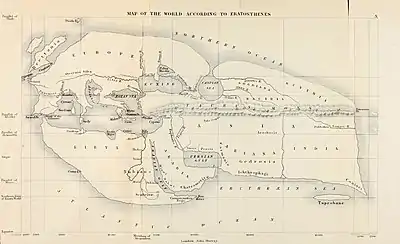
Homonoia (/hoʊmoʊˈnɔɪə/ Greek: Ὁμόνοια) is the concept of order and unity, being of one mind together[1][2] or union of hearts.[3] It was used by the Greeks to create unity in the politics of classical Greece. It saw widespread use when Alexander the Great adopted its principles to govern his vast Empire.
Interpretation
Classical Greeks
The concept of Homonoia was an ancient Greek concept which traditionally was not applied beyond their own culture. The Greeks viewed Homonoia as an absence of factional fighting in their city states.[1] The Greeks viewed outside cultures as "barbarians". The famed scholar Aristotle once told his student, a young Alexander the Great, "treat Greeks as friends, but [non-Greeks] as animals."[1]
It was the scholar Isocrates who first looked beyond the Greek people. While he didn't preach that the savages of the non-Greek world could be on par with the superior Greek people, he did believe they could be made Greek and thus be of one mind together. He claimed that Greekness could become a matter of nurture rather than nature.[4] It was during his time spent in the court of Philip II of Macedon that Isocrates was able to teach the concept to an influential audience. Philip II took much of the concept to heart, but he too viewed it as a method reserved for the Greeks. He used the concept as his driving force behind creating the Corinthian League, an alliance to unite the Greek States for a war against the Persian Empire. After Philip II was assassinated, his son Alexander the Great became King of Macedonia and himself became a proponent of Homonoia.
Alexander the Great
Alexander's tutor, Aristotle, viewed non-Greeks as barbarian animals.[1] Alexander however, ignored his teacher's indication and expanded on the concept of Homonoia. With an Empire covering most of the known world, Alexander sought to rule his subjects, whether they were Greek, Persian or Egyptian, under the concept of Homonoia.[1] In his short time as ruler of his vast Empire he tried to adopt customs of the cultures he conquered such as Persian dress and customs at his court, notably the custom of proskynesis, either a symbolic kissing of the hand, or prostration on the ground, that Persians paid to their social superiors.[5] He also married the officers of his army to Persian wives in an effort to further create a sense of oneness in his new Empire.[6] Through his policies he wanted to create a new Greco-Oriental empire as distinct from the more traditional system of a small ruling class of conquerors ruling over the recently vanquished. It was his practice to place the old style Persian satrap as governors but in the newly created offices of taxation and finance he placed Macedonians.[7] After his death most of his reforms lived on even as the Empire fragmented into successor states.
In the Romanized East
Homonoia was extended under Roman rule in the highly urbanized East as a symbolic mechanism for dealing with intra-city tensions and for linking the sometimes intensely individual eastern city-states.[8] A temple of Homonoia at Aphrodisias in Caria appears as the setting for the wedding of Callirhoe and Dionysios in the first-century CE romance Chaereas and Callirhoe; the temple is objectified in coinage of Aphrodisias that shows the cult statue of Aphrodite of Aphrodisias with those of other cities, under the legend homonoia: "Deities in the coin issues served as symbols that mediated the power within regional alliances, bolstered the prestige of the divine realm in human activity and provided the glue that bound together the political and the cosmic spheres."[9] In the first century CE, the Greek rhetor Dio Chrysostom sought in one of his Discourses to establish homonoia between two cities that each claimed the sobriquet "first city", Nicaea and Nicopolis.[10]
See also
Bibliography
- Notes
- 1 2 3 4 5 Mauriac 1949, p. 106
- ↑ Tarn 2002, p. 400
- ↑ Knoche, Grace F. (October 1974). "Of One Mind, of One Heart". Sunrise Magazine. theosociety.org. Retrieved October 13, 2009.
- ↑ Low 2007, p. 62
- ↑ Arrian 1983, VII, 11
- ↑ Tetlow 2005, p. 171
- ↑ Mauriac 1949, p. 108
- ↑ Price 1985, pp. 126–32
- ↑ Edwards 1994, p. 709 and bibliography
Edwards notes several examples of homonoia coinage. - ↑ Dio Chrysostom 1983, 28.22
- References
- Arrian (October 1983). Arrian: Anabasis of Alexander, Books 5–7. Indica. Loeb Classical Library. ISBN 0-674-99297-0. - Total pages: 608
- Dio Chrysostom (1983). Dio Chrysostom, II, Discourses 12-30. Translated by J. W. Cohoon. Harvard. Archived from the original on 2009-01-03. Retrieved 2009-10-26.
- Edwards, Douglas R. (Autumn 1994). "Defining the Web of Power in Asia Minor: The Novelist Chariton and His City Aphrodisias". Journal of the American Academy of Religion. Oxford University Press. 63 (3): 699–718. doi:10.1093/jaarel/LXII.3.699. JSTOR 1465210.
- Low, Polly (2007). Interstate Relations in Classical Greece: Morality and Power. Cambridge University Press. ISBN 978-0-521-87206-5. - Total pages: 313
- Mauriac, Henry M. de (January 1949). "Alexander the Great and the Politics of "Homonoia"". Journal of the History of Ideas. University of Pennsylvania Press. 10 (1): 104–114. doi:10.2307/2707202. JSTOR 2707202.
- Price, S. R. F. (1985). Rituals and power: the Roman imperial cult in Asia Minor. Cambridge University Press. ISBN 0-521-31268-X. - Total pages: 289
- Tarn, William Woodthorpe (2002). Alexander the Great, Volume 2. Cambridge University Press. ISBN 0-521-53137-3. - Total pages: 476
- Tetlow, Elisabeth Meier (2005). Women, Crime, and Punishment in Ancient Law and Society. Continuum International Publishing Group. ISBN 0-8264-1629-2. - Total pages: 300